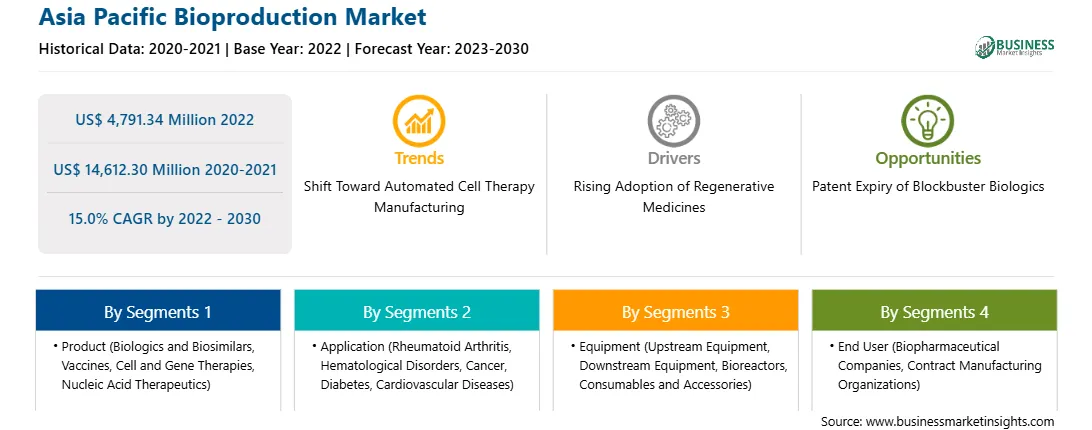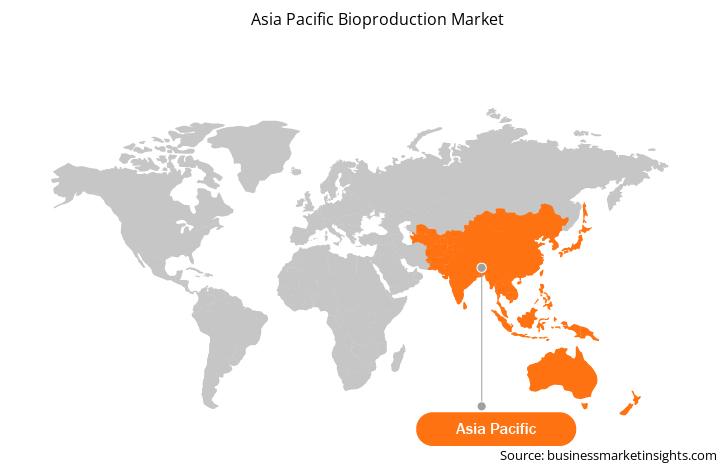The Asia Pacific bioproduction market was valued at US$ 4,791.34 million in 2022 and is expected to reach US$ 14,612.30 million by 2030; it is estimated to register a CAGR of 15.0% from 2022 to 2030.
Biologicals represent promising new therapies for previously incurable diseases and are becoming highly important in the pharmaceuticals market. Patents on originator biologicals are expected to expire in the coming years.
Estimated patent and exclusivity expiry dates for best-selling biologicals are given in the following table.
Biologicals Expiry Dates
Biologicals | Expiry Dates |
Avastin | January 2022 |
Cyramza | May 2023 |
Adcetris | August 2023 |
Abthrax | October 2024 |
Gazyva/Gazyvaro | November 2024 |
Darzalex | May 2026 |
Ocrevus | April 2027 |
Emgality | September 2028 |
Hemlibra | February 2028 |
Llumetri | March 2028 |
Imfinzi | September 2028 |
Mylotarg | April 2028 |
Imfinzi | September 2028 |
Mylotarg | April 2028 |
Sylvant | July 2034 |
The patent expiration and other intellectual property rights for originator biologicals will create a need to introduce new biosimilars in the future. As a result, competition among market players will surge in the industry in the coming years. Thus, the patent expiry of blockbuster biologics is expected to create lucrative opportunities for the bioproduction market during the forecast period.
The Asia Pacific bioproduction market is segmented into China, Japan, India, South Korea, Australia, South Korea, and the Rest of Asia Pacific. The growth of the market in Asia Pacific is anticipated to grow at a faster pace owing to factors such as growing need for superior treatment solutions, increasing focus on research and development activities, and favorable regulatory scenarios. Additionally, increasing investments and developing healthcare infrastructure to boost research activities are estimated to drive the Asia Pacific bioproduction market during 2022–2030.
In China, the demand for healthcare is increasing rapidly. Factors such as growing geriatric population, rising incidence of chronic diseases, and increasing government initiatives in the healthcare sector are driving the cell therapy market in China. Improvements in basic and private medical insurance plans have also accelerated the growth of the medical sector in the country. The rising income levels have led to the demand for more sophisticated healthcare services. The rise in the geriatric population has led to an increase in the specialty medical community in the country. In China, the growing prevalence of cancer is likely to increase the adoption of cell therapy. According to the National Central Cancer Registry of China, 4.3 million new cancer cases were registered in China.
Strategic insights for the Asia Pacific Bioproduction provides data-driven analysis of the industry landscape, including current trends, key players, and regional nuances. These insights offer actionable recommendations, enabling readers to differentiate themselves from competitors by identifying untapped segments or developing unique value propositions. Leveraging data analytics, these insights help industry players anticipate the market shifts, whether investors, manufacturers, or other stakeholders. A future-oriented perspective is essential, helping stakeholders anticipate market shifts and position themselves for long-term success in this dynamic region. Ultimately, effective strategic insights empower readers to make informed decisions that drive profitability and achieve their business objectives within the market.

| Report Attribute | Details |
|---|---|
| Market size in 2022 | US$ 4,791.34 Million |
| Market Size by 2030 | US$ 14,612.30 Million |
| Global CAGR (2022 - 2030) | 15.0% |
| Historical Data | 2020-2021 |
| Forecast period | 2023-2030 |
| Segments Covered |
By Product
|
| Regions and Countries Covered | Asia-Pacific
|
| Market leaders and key company profiles |
The geographic scope of the Asia Pacific Bioproduction refers to the specific areas in which a business operates and competes. Understanding local distinctions, such as diverse consumer preferences (e.g., demand for specific plug types or battery backup durations), varying economic conditions, and regulatory environments, is crucial for tailoring strategies to specific markets. Businesses can expand their reach by identifying underserved areas or adapting their offerings to meet local demands. A clear market focus allows for more effective resource allocation, targeted marketing campaigns, and better positioning against local competitors, ultimately driving growth in those targeted areas.

The Asia Pacific bioproduction market is categorized into product, application, equipment, end user, and country.
Based on product, the Asia Pacific bioproduction market is segmented into biologics and biosimilars, vaccines, cell and gene therapies, nucleic acid therapeutics, and others. The biologics and biosimilars segment held the largest Asia Pacific bioproduction market share in 2022.
In terms of application, the Asia Pacific bioproduction market is segmented into rheumatoid arthritis, hematological disorders, cancer, diabetes, cardiovascular diseases, and others. The cancer segment held the largest Asia Pacific bioproduction market share in 2022.
By equipment, the Asia Pacific bioproduction market is divided into upstream equipment, downstream equipment, bioreactors, and consumables and accessories. The consumables and accessories segment held the largest Asia Pacific bioproduction market share in 2022.
In terms of end user, the Asia Pacific bioproduction market is categorized into biopharmaceutical companies, contract manufacturing organizations, and others. The biopharmaceutical companies segment held the largest Asia Pacific bioproduction market share in 2022.
By country, the Asia Pacific bioproduction market is segmented into Australia, China, India, Japan, South Korea, and the Rest of Asia Pacific. China dominated the Asia Pacific bioproduction market share in 2022.
Lonza Group AG, bbi-biotech GmbH, Danaher Corp, Sartorius AG, FUJIFILM Irvine Scientific Inc, Thermo Fisher Scientific Inc, Merck KGaA, F. Hoffmann-La Roche Ltd, and Bio-Rad Laboratories Inc. are some of the leading companies operating in the Asia Pacific bioproduction market.
1. Lonza Group AG
2. bbi-biotech GmbH
3. Danaher Corp
4. Sartorius AG
5. FUJIFILM Irvine Scientific Inc
6. Thermo Fisher Scientific Inc
7. Merck KGaA
8. F. Hoffmann-La Roche Ltd
9. Bio-Rad Laboratories Inc
The Asia Pacific Bioproduction Market is valued at US$ 4,791.34 Million in 2022, it is projected to reach US$ 14,612.30 Million by 2030.
As per our report Asia Pacific Bioproduction Market, the market size is valued at US$ 4,791.34 Million in 2022, projecting it to reach US$ 14,612.30 Million by 2030. This translates to a CAGR of approximately 15.0% during the forecast period.
The Asia Pacific Bioproduction Market report typically cover these key segments-
The historic period, base year, and forecast period can vary slightly depending on the specific market research report. However, for the Asia Pacific Bioproduction Market report:
The Asia Pacific Bioproduction Market is populated by several key players, each contributing to its growth and innovation. Some of the major players include:
The Asia Pacific Bioproduction Market report is valuable for diverse stakeholders, including:
Essentially, anyone involved in or considering involvement in the Asia Pacific Bioproduction Market value chain can benefit from the information contained in a comprehensive market report.